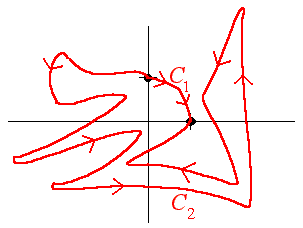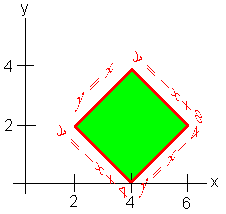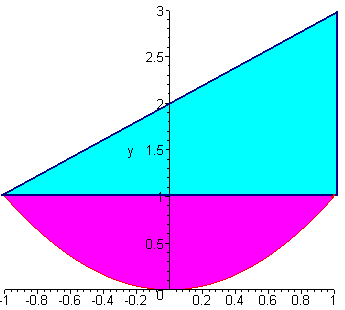Math 202 Practice Final
Please work out each of the given problems. Credit will be based on the steps that you show towards the final answer. Show your Work
Problem 1 Please answer the following true or false. If false, explain why or provide a counter example. If true, explain why.
A. Let Q be a three dimensional solid and let
F(x,y,z) = (x2y + sin z)i+ (cos x - xy2)j + (3xy + z)k
and let S be the boundary of Q with outwardly pointing normal. The the volume so Q is given by
![]()
True,
We have
divF = 2xy - 2xy + 1 = 1
Using the divergence theorem, we see that
![]()
which is just the volume of the solid.
B. Let F = 3xy i + cosx j and let C1 and C2 be as shown below. Then
![]()

False for many reasons. First, F is not conservative. Hence even if the other issue was not there, this would be false. Second, Green's Theorem needs Fodr, not FoNdr.
C. A new particle, the fluxon, has been discovered to be emitted from the sun. The particle emits a force field
F(x,y,z) = (y2 - z) i + (x2 - z) j + (x2 + y2) k
where the origin represents the center of the sun. If the total flux through the earth's northern hemisphere has been calculated as 10,000, then the total flux through the earth's southern hemisphere must also be 10,000.
False, since divF = 0, the total flux must be zero. If the flux through the northern hemisphere is 10,000, then the flux through the southern hemisphere must be -10,000.
Problem 2 You are the captain of the spaceship Potential that you have programmed to follow the vector-valued function
r(t) = (t2 + 5) i + (t - 3) j + t3 k
where t is measured in hours. However, at time t = 2, your engines fail and your ship begins drifting in deep space. There is a deep space station located at (6,2,38).
A. Find the vector-valued function that describes the Potential's flight after the engines failed. Use t = 2 to represent the time at which your engines first shut down. (Hint: This should be a linear vector valued function.)
The flight will go in a linear path in the direction of the unit tangent vector with speed equal to the speed when the engines fail. We have
r'(t) = 2t i + j + 3t2 k
r'(2) = 4i + j + 12k
When t = 2, the spacecraft is at
r(2) = 9i - j + 8k
The flight can be described by
rf(t) = r(2) + (t - 2)r'(2) = 9i - j + 8k + (t - 2)(4i + j + 12k)
= (1 + 4t)i + (-3 + t)j + (-16 + 12t)k
B. Will your ship make it to the station, or will you float helplessly for eternity?
We are looking for a time t with
rf(t) = 6i + 2j + 38j
Setting the j components equal we get
-3 + t = 3 t = 5
However
rf(5) = 9i + 2j + 44k
since the i and k components of rf and the station are different, we can conclude that our spaceship will drift away to eternity.
Problem 3 Show that the helix
r(t) = (R cos t) i + (R sin t) j + t k
where R is a positive constant, has the property that N(t) . r(t) is a constant. Find this constant.
We first calculate T(t)
r'(t) = (-R sin t) i + (R cos t) j + k
|| r'(t)|| = (R2 sin2 t + R2 cos2 t + 1)1/2 = (R2 + 1)1/2
Hence
T(t) = (R2 + 1)-1/2 [(-R sin t) i + (R cos t) j + k]
Next, we have
T'(t) = (R2 + 1)-1/2 [(-R cos t) i + (-R sin t) j]
and
||T'(t)|| = (R2 + 1)-1/2 [R2 cos2 t + R2 sin2 t]1/2 = (R2 + 1)-1/2 [R]
Dividing gives
N(t) = -cos t i - sin t j
Finally, we take the dot product
N(t) . r(t) = [(R cos t) i + (R sin t) j + t k] . [-cos t i - sin t j]
= R cos2 t + R sin2 t = R
Problem 4 The probability density function for an event is given by

where R is the square with vertices (4,0), (6,2), (4,4), and (2,2).
A. Use the appropriate change of variables (Jacobians) to find k that is solve
![]()
We sketch the picture and find the equation of the four lines that border the square.

We can also write
0 < x - y < 4 and 4 < x + y < 8
We let
u = x - y v = x + y
Adding the two equations gives
u + v = 2x x = 1/2 (u + v)
Subtracting the two equations gives
v - u = 2y y = 1/2 (v - u)
We can compute the Jacobian

We have

Setting this equal to 1 gives
3
k =
896
B. Find the probability that 0 < x - y < 1
Since
u = x - 1
we just adjust the limits appropriately

Problem 5 Switch the order of integration and write as one double integral

The key to this problem is to sketch the picture which is shown below

Now we can realize the region as being bounded from below by y = x2 and above by y = x + 2. We have

Problem 6 Set up the integrals that give the following. Use the most appropriate coordinate system.
A. The mass of the solid that lies inside the sphere
x2 + y2 + z2 = 9
and outside the cone
z2 = x2 + y2
that has density function
![]()
We use spherical coordinates. The sphere becomes
r = 3
and to find the equation of the cone, we add z2 to both sides to get
2z2 = x2 + y2 + z2
2r2cos2 f = r2 cos2 f = 1/2 f = p/4
Now we can write

B. The surface area of the part of the paraboloid
z = x2 + y2
that lies inside the cylinder
x2 + y2 = 4
We calculate the partials
zx = 2x zy = 2y (1 + zz + zy)1/2 = (1 + 4x2 + 4y2)1/2
Since the region is a circle of radius 2, we convert to polar coordinates to get

Problem 7 Find the work done by the force field
F(x,y) = (3x2 - y) i + (x2 - y3) j
as a particle moves counterclockwise around the rectangle with vertices (2,1), (5,1), (5,5), and (2,5).
We use Green's Theorem. We have
Nx - My = 2x + 1
We have

Problem 8
Verify Stokes Theorem where
F(x,y,z) = (2x) i + (2y) j + (z sin z3) k
and S is part of the paraboloid
z = 9 - x2 - y2
that lies above the plane z = 8 oriented upward.
We first compute the line integral
![]()
We notice that the intersection of the paraboloid and the plane is given by
9 - x2 - y2 = 8 x2 + y2 = 1
This is the circle of radius 1 raised 8 units above the xy-plane. Its parameterization is given by
r(t) = (cos t) i + (sin t) j + 8k
r'(t) = (-sin t) i + (cos t) j
so that
F . dr = [(2cos t) i + (2sin t) j + (8 sin 83) k] . [(-sin t) i + (cos t) j]
= -2 sin t cos t + 2 sin t cos t = 0
Since the integrand is zero, so is the integral.
Now we use Stokes Theorem. We have

So that the surface integral is zero.
Problem 9
Use the transformations
S(u,v,w): x(u,v,w) = u - v + w, y(u,v) = v+w, z(u,v,w) = 2w
and
T(u,v,w): u(r,s,t) = rsin(s)cos(t), v(r,s,t) = rsin(s)sin(t), w(r,s,t) = rcos(s)
To represent the volume of the solid inside of
(x + y - z)2 + (y - z/2)2 + (z/2)2 = 4
as a triple integral with constants for all the bounds.Solution
First notice that if we solve for u,v, and w in terms of x,y, and z we get
Thus under S, the solid becomes
u2 + v2 + w2 = 4
Next, note that the transformation T is just spherical coordinates. Thus the limits are
0 < r < 2, 0 < s < p, 0 < t < 2p
Since we are finding the volume, the integrand is just the Jacobian. We have

and
JSoT = JSJT
Putting this all together gives
